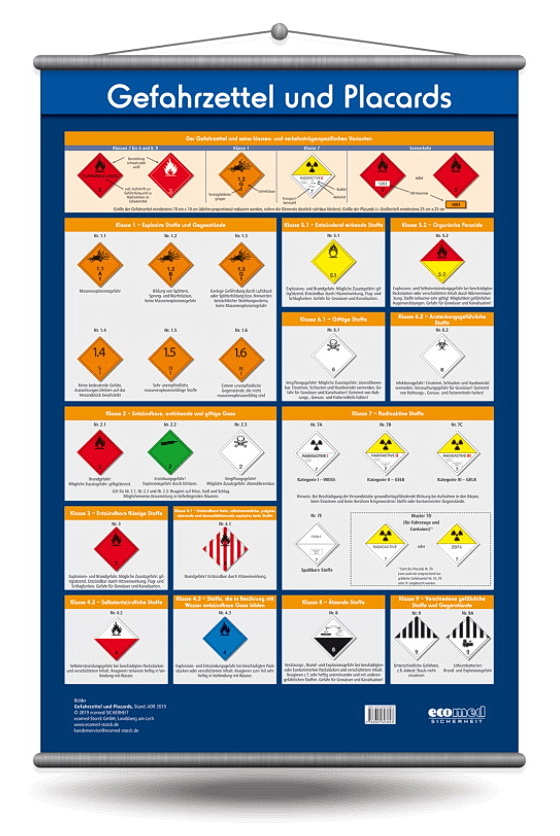Wall panel ‘Hazard labels and placards’
€34.57
Product number:
400520
Product information "Wall panel ‘Hazard labels and placards’"
Wall panel, format 70.0 x 100 cm
At a glance: The current hazard labels and placards.
At a glance: The current hazard labels and placards.
The hazard labels and placards wall chart offers a multimodal (ADR, RID, IMDG Code, IATA-DGR) compilation of all hazard labels and placards, sorted by class and based on the current legal status, with a short, concise description of the meaning and hazard potential. The individual elements of the various hazard labels are described. References to variants are also included.
You will find the following blocks on our wall chart:
- The hazard label and its class- and carrier-specific variants
- A clear presentation of the symbols and inscriptions/numbers on a ‘standard’ hazard label for classes 2-6, 8 and 9 and the special features of classes 1 (subclass/compatibility group) and 7 (nuclide/activity/transport code). In addition, the possible variant with UN number in the hazard label or the combination of UN number in orange-coloured rectangle in combination with hazard label is listed.
- Class 1 - Explosive substances and articles: Presentation of hazard label numbers 1.1 to 1.6 with, in some cases, an exemplary combination of subclass and compatibility group.
Class 2 - Flammable, asphyxiating and toxic gases
- Class 3 - Flammable liquids
- Class 4.1 - Flammable solid, self-reactive, polymerising and desensitised explosive solids
- Class 4.2 - Spontaneously flammable substances
- Class 4.3 - Substances which, in contact with water, emit flammable gases
- Class 5.1 - Flammable substances
- Class 5.2 - Organic peroxides
- Class 6.1 - Toxic substances
- Class 6.2 - Infectious substances
- Class 7 - Radioactive substances
- Class 8 - Corrosive substances
- Class 9 - Miscellaneous dangerous substances and objects
Due to the tear-resistant material and the high-quality and dimensionally stable hanging device, the wall board is suitable for both stationary and mobile use in the training area.
The blackboard (with hanger) is used as teaching material.
You will find the following blocks on our wall chart:
- The hazard label and its class- and carrier-specific variants
- A clear presentation of the symbols and inscriptions/numbers on a ‘standard’ hazard label for classes 2-6, 8 and 9 and the special features of classes 1 (subclass/compatibility group) and 7 (nuclide/activity/transport code). In addition, the possible variant with UN number in the hazard label or the combination of UN number in orange-coloured rectangle in combination with hazard label is listed.
- Class 1 - Explosive substances and articles: Presentation of hazard label numbers 1.1 to 1.6 with, in some cases, an exemplary combination of subclass and compatibility group.
Class 2 - Flammable, asphyxiating and toxic gases
- Class 3 - Flammable liquids
- Class 4.1 - Flammable solid, self-reactive, polymerising and desensitised explosive solids
- Class 4.2 - Spontaneously flammable substances
- Class 4.3 - Substances which, in contact with water, emit flammable gases
- Class 5.1 - Flammable substances
- Class 5.2 - Organic peroxides
- Class 6.1 - Toxic substances
- Class 6.2 - Infectious substances
- Class 7 - Radioactive substances
- Class 8 - Corrosive substances
- Class 9 - Miscellaneous dangerous substances and objects
Due to the tear-resistant material and the high-quality and dimensionally stable hanging device, the wall board is suitable for both stationary and mobile use in the training area.
The blackboard (with hanger) is used as teaching material.

